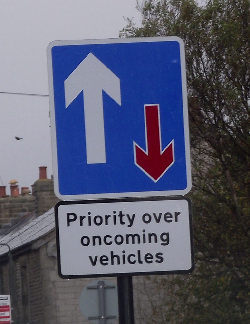Teaching meeting
 In addition to the notes below, study the 'Meeting other Traffic' section at DriverActive.
In addition to the notes below, study the 'Meeting other Traffic' section at DriverActive.
Many students and qualified instructors alike have difficulty when teaching their learners to deal with 'meet' situations.
There might be a number of reasons for this; possibly the instructions are not given early enough, or it could be that the initial meeting routes are too complex (during lessons with 'real learners').
Whatever the reason, the ideas offered here will help you to teach 'meeting' safely.
Driving test requirements
When your customers take their driving tests they will need to show consideration for other drivers, but should not give way unduly to other vehicles when it would be normal to proceed.
Drivers must always be prepared to wait where there is an obstruction on their side of the road or where there is not enough room for two vehicles to pass safely.
Examples of DVSA assessment Criteria
The examiner will consider any meeting errors that you allow to happen during your test, regardless of the lesson subject that you are teaching.
Depending on the chosen lesson and standard of your Part-Three learner you might not be able to prevent a meeting error before it happens - or alternatively, an error might arise during a phase of the lesson where the learner is taking full responsibility for their own driving, however, you should not allow any errors to be repeated.
Repeated errors (in any subject) suggest that you lack control of the lesson.
'Driving Fault'
Late reaction when meeting approaching vehicles.
This can happen if you are a little late with your instruction (or other input) when required.
'Serious Fault'
Placing other drivers at risk by the learner driving forward when they should have clearly given way.
This can happen if you are very late with necessary instruction (or other input) or fail to offer help where required. It can also happen if the learner is unsure about their responsibilities (job-sharing).
'Dangerous Fault'
Any situation brought about by the inability to meet approaching traffic that results in actual danger to your vehicle and the general public or property. Dangerous faults should be prevented - with physical intervention if necessary. A dangerous meeting fault is only likely to occur if you are on a route that over stretches the learner or if you are not assisting verbally where required.
Priority can only be given
 Your learners need to know about 'priority'.
Your learners need to know about 'priority'.
The 'priority can only be given, not taken' rule is probably one of the most important learning points for the meeting lesson.
Ensure that your learners are fully aware that there is no automatic 'right of way' in any situation, regardless of which side of the road an obstruction is on or road signs that might indicate priority.
Other drivers might demonstrate careless or thoughtless actions by ignoring 'give priority' signs or pushing through narrow gaps - but your learner must always be prepared to give way (or crash!) - this means you need to be watching for potential danger situations well before they develop.
Notice that the sign shown on the right is an information sign - whereas the circular 'Give priority to approaching traffic' sign is a compulsory sign.
Judging the situation
In order to meet vehicles safely your learners need to be able to judge available road width with reasonable accuracy and gauge the speed of approaching traffic. Equally importantly, they also need to feel secure in the fact that they will not find themselves 'stuck' in a potentially embarrassing situation.
Many learner drivers experience anxiety when they are unsure how to proceed in a specific situation. Examiners are very good at emulating this anxiety and displaying it in their role-play drive.
In meet situations new drivers are often concerned about the 'go or don't go' decision. However, this can be easily addressed by offering an alternative way to consider the situation.
Wait, go, or don't know...
When meeting vehicles in the early stages of learning many (most) learners feel a sense of anxiety about making wait/go decisions in situations that are not clear cut. This can often lead to decisions being left too late with all the consequent problems. Each time things go wrong the learner feels more inadequate until, in some cases, they become fearful of meet situations.
The solution is fairy simple! Offer a third legitimate option when approaching meet, or any other situations.
The third option is to legitimise 'don't know' as an approach option. In other words, make it clear that 'don't know' is perfectly acceptable! It's OK to 'don't know'.
In fact, not only is 'don't know' acceptable – it's desirable. It is this approach to driving that keeps the good defensive driver safe by using the following rule:
"If you don't know, don't go!"
Now, in order to make this work for your learners you will need to expand the rule slightly by adding some decision criteria – you can do this with notional 'distance markers'.
Example
"As we approach the parked car there are three courses of action you can take. If you can clearly see that there is an approaching vehicle that will prevent you from proceeding you will stop and give way (wait). If the road is safe and clear you can proceed (go).
If you are unsure (don't know) about whether if is OK to proceed that's also OK, however, in this situation there will come a point where you must convert 'don't know' into 'don't go'. Initially we can set this point at 50 metres.
If when you are about 50 metres away from the parked vehicle you still don't know, the decision is made for you - don't go. As you develop your skills you will be able to leave this decision later."
By adopting the 'don't know' rule you will help your learner to relax and concentrate on the situation ahead rather than their own anxiety.
For this to work well you need to support your learner's decisions. Comments like "You should have gone through that gap" will do little to help your learner develop their judgment or their confidence.
Next: Step 3 - Common problems...